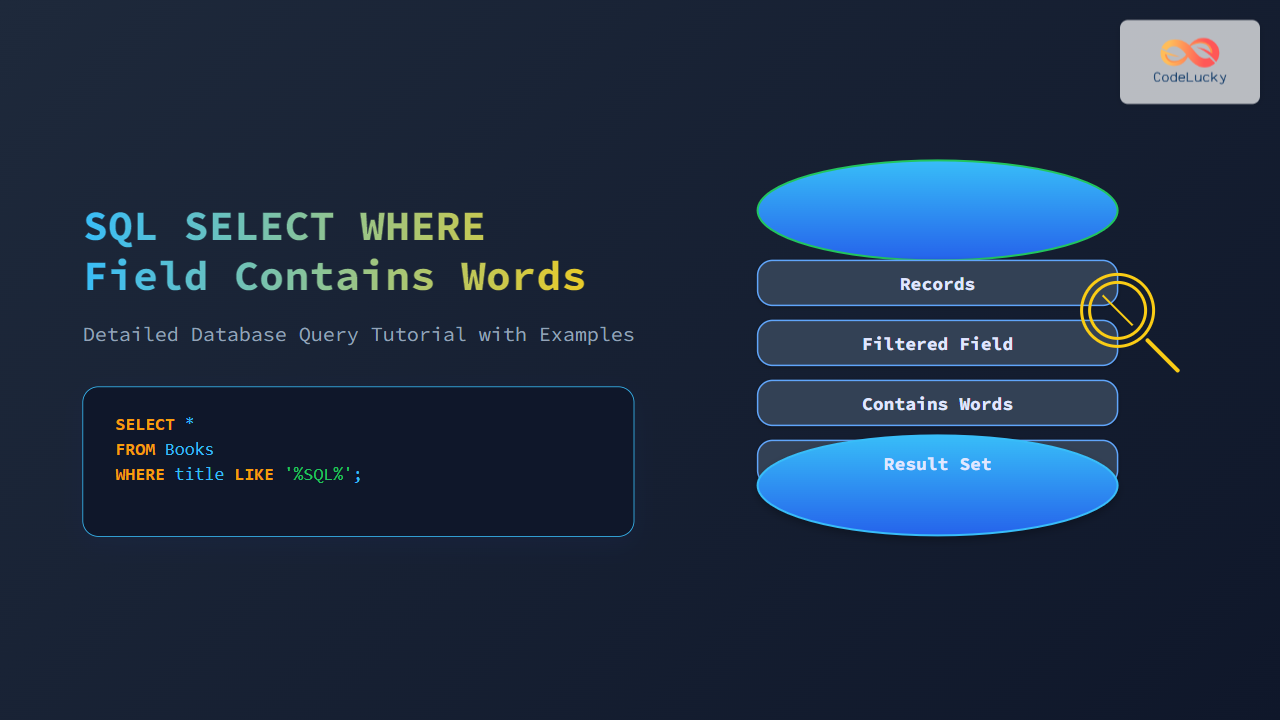In the world of data analysis and database management, finding the smallest value in a dataset is a common and crucial task. Whether you're identifying the lowest price of a product, the earliest date in a series, or the minimum score in a test, the SQL MIN() function is your go-to tool. This powerful aggregate function allows you to quickly and efficiently retrieve the smallest value from a set of records, making it an essential part of any SQL developer's toolkit.
Understanding the SQL MIN() Function
The MIN() function is an aggregate function in SQL that returns the minimum value from a set of values. It can be used with various data types, including numbers, dates, and strings. When applied to strings, it returns the value that would appear first in alphabetical order.
📊 The basic syntax of the MIN() function is:
SELECT MIN(column_name) FROM table_name;
Let's dive into some practical examples to see how this function works in different scenarios.
Example 1: Finding the Lowest Price in a Product Catalog
Imagine you're working with an e-commerce database and need to find the lowest priced item in your product catalog. Here's how you'd use the MIN() function to accomplish this:
CREATE TABLE products (
product_id INT PRIMARY KEY,
product_name VARCHAR(100),
price DECIMAL(10, 2)
);
INSERT INTO products (product_id, product_name, price) VALUES
(1, 'Laptop', 999.99),
(2, 'Smartphone', 599.99),
(3, 'Headphones', 149.99),
(4, 'Tablet', 399.99),
(5, 'Smartwatch', 249.99);
SELECT MIN(price) AS lowest_price FROM products;
Output:
| lowest_price |
|————–|
| 149.99 |
In this example, we created a 'products' table and inserted some sample data. The MIN() function is then used to find the lowest price among all products. The result shows that the lowest priced item costs $149.99.
Example 2: Finding the Earliest Order Date
Let's consider a scenario where you need to find the earliest order date from an orders table:
CREATE TABLE orders (
order_id INT PRIMARY KEY,
customer_id INT,
order_date DATE,
total_amount DECIMAL(10, 2)
);
INSERT INTO orders (order_id, customer_id, order_date, total_amount) VALUES
(1, 101, '2023-01-15', 250.00),
(2, 102, '2023-02-03', 175.50),
(3, 103, '2023-01-07', 320.75),
(4, 104, '2023-03-22', 95.25),
(5, 105, '2023-02-18', 410.00);
SELECT MIN(order_date) AS earliest_order FROM orders;
Output:
| earliest_order |
|—————-|
| 2023-01-07 |
Here, we've created an 'orders' table and inserted sample order data. The MIN() function is used to find the earliest order date. The result shows that the earliest order was placed on January 7, 2023.
Example 3: Finding the Minimum Value in Each Group
The MIN() function becomes even more powerful when combined with the GROUP BY clause. This allows you to find the minimum value for each group in your data.
Let's expand our previous example to find the earliest order date for each customer:
INSERT INTO orders (order_id, customer_id, order_date, total_amount) VALUES
(6, 101, '2023-04-05', 180.00),
(7, 102, '2023-03-12', 225.50),
(8, 103, '2023-02-28', 150.25);
SELECT customer_id, MIN(order_date) AS earliest_order
FROM orders
GROUP BY customer_id
ORDER BY customer_id;
Output:
| customer_id | earliest_order |
|————-|—————-|
| 101 | 2023-01-15 |
| 102 | 2023-02-03 |
| 103 | 2023-01-07 |
| 104 | 2023-03-22 |
| 105 | 2023-02-18 |
In this example, we've added more orders to our table and used the MIN() function with GROUP BY to find the earliest order date for each customer. The results show the earliest order date for each unique customer_id.
Example 4: Using MIN() with String Values
The MIN() function can also be used with string values. In this case, it returns the value that would appear first in alphabetical order.
Let's create a table of employees and find the employee with the name that comes first alphabetically:
CREATE TABLE employees (
employee_id INT PRIMARY KEY,
first_name VARCHAR(50),
last_name VARCHAR(50),
department VARCHAR(50)
);
INSERT INTO employees (employee_id, first_name, last_name, department) VALUES
(1, 'John', 'Doe', 'Sales'),
(2, 'Jane', 'Smith', 'Marketing'),
(3, 'Alice', 'Johnson', 'IT'),
(4, 'Bob', 'Williams', 'HR'),
(5, 'Charlie', 'Brown', 'Finance');
SELECT MIN(first_name) AS first_alphabetically FROM employees;
Output:
| first_alphabetically |
|———————-|
| Alice |
In this example, we've created an 'employees' table and used the MIN() function on the first_name column. The result shows that 'Alice' is the first name that appears alphabetically.
Example 5: Combining MIN() with Other SQL Functions
The MIN() function can be combined with other SQL functions to perform more complex operations. Let's say we want to find the employee with the shortest last name:
SELECT first_name, last_name
FROM employees
WHERE LENGTH(last_name) = (SELECT MIN(LENGTH(last_name)) FROM employees);
Output:
| first_name | last_name |
|————|———–|
| John | Doe |
In this example, we've used a subquery with the MIN() function to find the length of the shortest last name, and then used this in the WHERE clause to find the employee(s) with that shortest last name.
Example 6: Using MIN() with a CASE Statement
The MIN() function can also be used in conjunction with a CASE statement to find the minimum value based on certain conditions. Let's say we want to find the lowest price for products in different categories:
CREATE TABLE products_extended (
product_id INT PRIMARY KEY,
product_name VARCHAR(100),
category VARCHAR(50),
price DECIMAL(10, 2)
);
INSERT INTO products_extended (product_id, product_name, category, price) VALUES
(1, 'Laptop', 'Electronics', 999.99),
(2, 'Smartphone', 'Electronics', 599.99),
(3, 'T-shirt', 'Clothing', 19.99),
(4, 'Jeans', 'Clothing', 49.99),
(5, 'Book', 'Books', 14.99),
(6, 'Tablet', 'Electronics', 399.99);
SELECT
MIN(CASE WHEN category = 'Electronics' THEN price END) AS min_electronics_price,
MIN(CASE WHEN category = 'Clothing' THEN price END) AS min_clothing_price,
MIN(CASE WHEN category = 'Books' THEN price END) AS min_books_price
FROM products_extended;
Output:
| min_electronics_price | min_clothing_price | min_books_price |
|———————–|——————–|—————–|
| 399.99 | 19.99 | 14.99 |
In this example, we've used the MIN() function with a CASE statement to find the lowest price for each product category in a single query. This approach is particularly useful when you need to find minimum values for different subsets of your data simultaneously.
Best Practices and Considerations
When using the MIN() function, keep these tips in mind:
-
🎯 Indexing: If you frequently use MIN() on a particular column, consider creating an index on that column to improve query performance.
-
🧮 NULL values: The MIN() function ignores NULL values. If a column contains only NULL values, MIN() will return NULL.
-
🔍 Combining with WHERE: You can use the WHERE clause to filter the rows before applying the MIN() function, which can be useful for finding minimums within specific subsets of your data.
-
📊 Data types: Be aware of the data type you're working with. MIN() will return different results for numeric, string, and date data types.
-
🔄 Alternatives: In some cases, using ORDER BY with LIMIT 1 can achieve the same result as MIN() and may be more flexible for complex queries.
Conclusion
The SQL MIN() function is a powerful tool for finding the smallest value in a dataset. Whether you're working with numbers, dates, or strings, MIN() provides a quick and efficient way to retrieve minimum values. By combining MIN() with other SQL features like GROUP BY, CASE statements, and subqueries, you can perform complex data analysis tasks with ease.
Remember, while MIN() is excellent for finding single minimum values, it's often just the starting point for more complex data analysis. As you become more comfortable with MIN(), you'll find it an invaluable part of your SQL toolkit, enabling you to extract crucial insights from your data efficiently.
Keep practicing with different scenarios and data types to master the use of the MIN() function in your SQL queries. Happy coding! 🚀💻
- Understanding the SQL MIN() Function
- Example 1: Finding the Lowest Price in a Product Catalog
- Example 2: Finding the Earliest Order Date
- Example 3: Finding the Minimum Value in Each Group
- Example 4: Using MIN() with String Values
- Example 5: Combining MIN() with Other SQL Functions
- Example 6: Using MIN() with a CASE Statement
- Best Practices and Considerations
- Conclusion



















